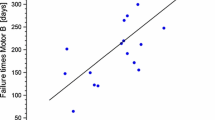Abstract
In this paper, we develop a new class of bivariate counting processes that have ‘marginal regularity’ property. But, the ‘pooled processes’ in the developed class of bivariate counting processes are not regular. Therefore, the proposed class of processes allows simultaneous occurrences of two types of events, which can be applicable in practical modeling of counting events. Initially, some basic properties of the new class of bivariate counting processes will be discussed. Based on the obtained properties, the joint distributions of the numbers of events in time intervals will be derived and the dependence structure of the bivariate process will be discussed. Furthermore, the marginal and conditional processes will be studied. The application of the proposed bivariate counting process to a shock model will also be considered. In addition, the generalization to the multivariate counting processes will be discussed briefly.
Similar content being viewed by others
References
A-Hameed MS, Proschan F (1973) Nonstationary shock models. Stoch Process Appl 1:83–404
Andersen PK, Borgan Ø, Gill RD, Keiding N (2012) Statistical models based on counting processes. Springer Science Business Media
Allen F, Gale D (2000) Financial contagion. J Polit Econ 108:1–34
Aven T, Jensen U (1999) Stochastic models in reliability. Springer, New York
Aven T, Jensen U (2000) A general minimal repair model. J Appl Probab 37:187–197
Beer FP, Johnston ER, DeWolf JT (2004) Mechanics of materials. McGraw-Hill, New Delhi
Burton R, Waymire E (1985) Scaling limits for associated random measures. Ann Probab 13:1267–1278
Cai J, Li H (2005) Multivariate risk model of phase type. Insur Math Econ 36:137–152
Cha JH (2014) Characterization of the generalized Polya process and its applications. Adv Appl Probab 46:1148–1171
Cha JH, Finkelstein M (2009) On a terminating shock process with independent wear increments. J Appl Probab 46:353–362
Cha JH, Finkelstein M (2011) On new classes of extreme shock models and some generalizations. J Appl Probab 48:258–270
Cha JH, Finkelstein M (2016) New shock models based on the generalized Polya process. Europ J Oper Res 251:135–141
Cha JH, Giorgio M (2016) On a class of multivariate counting processes. Adv Appl Probab 48:443–462
Chan WS, Hailiang Yang H, Zhang L (2003) Some results on ruin probabilities in a two-dimensional risk model. Insurance: Mathematics and Economics 32:345–358
Chevallier J, Caceres MJ, Doumic M, Reynaud-Bouret P (2015) Microscopic approach of a time elapsed neural model. Math Models Methods Appl Sci 25:2669–2719. MR-3411353
Cox DR, Lewis PAW (1972) Multivariate point processes. In: LeCam, L M (ed) Proceedings of the Sixth Berkeley symposium in mathematical statistics, pp 401–448
Esary JD, Proschan F, Walkup DW (1967) Association of random variables, with applications. Ann Math Statist 38:1466–1474
Esary JD, Marshall AW, Proschan F (1973) Shock models and wear processes. Ann Probab 1:627–649
Evans SN (1990) Association and random measures. Probab Theory Relat Fields 86:1–19
Finkelstein M, Cha JH (2013) Stochastic modelling for reliability (shocks, burn-in and heterogeneous populations). Springer, London
Frostig E, Kenzin M (2009) Availability of inspected systems subject to shocks-A matrix algorithmic approach. Eur J Oper Res 193:168–183
Kundu D, Gupta RD (2009) Bivariate generalized exponential distribution. J Multivar Anal 100:581–593
Kundu D, Gupta RD (2010) Modified Sarhan-Balakrishnan singular bivariate distribution. J Statist Plan Infer 140:526–538
Limnios N, Oprişan G (1999) A unified approach for reliability and performability evaluation of semi-Markov systems. Appl Stoch Models Business Indus 15:353–368
Limnios N, Oprişan G (2001) Semi-Markov processes and reliability. Boston, Birkhäuser
Limnios N, Ouhbi B (2006) Nonparametric estimation of some important indicators in reliability for semi-Markov processes. Statist Methodol 3:341–350
Marshall AW, Olkin I (1967) A multivariate exponential distribution. J Amer Statist Assoc 62:30–44
Mercier S, Pham HH (2016) A random shock model with mixed effect, including competing soft and sudden failures, and dependence. Methodol Comput Appl Probab 18:377–400
Montoro-Cazorla D, Pérez-Ocón R, Segovia MC (2009) Shock and wear models under policy N using phase-type distributions. Appl Math Modell 33:543–554
Montoro-Cazorla D, Pérez-Ocón R (2011) Two shock and wear systems under repair standing a finite number of shocks. Eur J Oper Res 214:298–307
Montoro-Cazorla D, Pérez-Ocón R (2015) A reliability system under cumulative shocks governed by a BMAP. Appl Math Modell 39:7620–7629
Perkel DH, Gerstein GL, Moor GP (1967) Neuronal spike trains and stochastic point processes II. Simultaneous spike trains. Biophys J 7:419–440
Segovia MC, Labeau PE (2013) Reliability of a multi-state system subject to shocks using phase-type distributions. Appl Math Modell 37:4883–4904
Sheu SH, Chen YL, Chang CC, Zhang ZG (2016) A note on a two variable block replacement policy for a system subject to non-homogeneous pure birth shocks. Appl Math Modell 40:3703–3712
Woo JK (2016) On multivariate discounted compound renewal sums with time-dependent claims in the presence of reporting/payment delays. Insur Math Econ 70:354–363
Acknowledgments
The authors would like to thank the Editor and referees for helpful comments and valuable suggestions, which have improved the presentation of this paper considerably. The authors acknowledge that one of the referees’ insightful advice has led Theorem 2 to a more general result on association. The work of the first author was supported by Priority Research Centers Program through the National Research Foundation of Korea (NRF) funded by the Ministry of Education, Science and Technology (2009-0093827). The work of the first author was also supported by the National Research Foundation of Korea (NRF) grant funded by the Korea government (MSIP) (No. 2016R1A2B2014211).
Author information
Authors and Affiliations
Corresponding author
Rights and permissions
About this article
Cite this article
Cha, J.H., Giorgio, M. Modelling of Marginally Regular Bivariate Counting Process and its Application to Shock Model. Methodol Comput Appl Probab 20, 1137–1154 (2018). https://doi.org/10.1007/s11009-018-9633-4
Received:
Revised:
Accepted:
Published:
Issue Date:
DOI: https://doi.org/10.1007/s11009-018-9633-4




